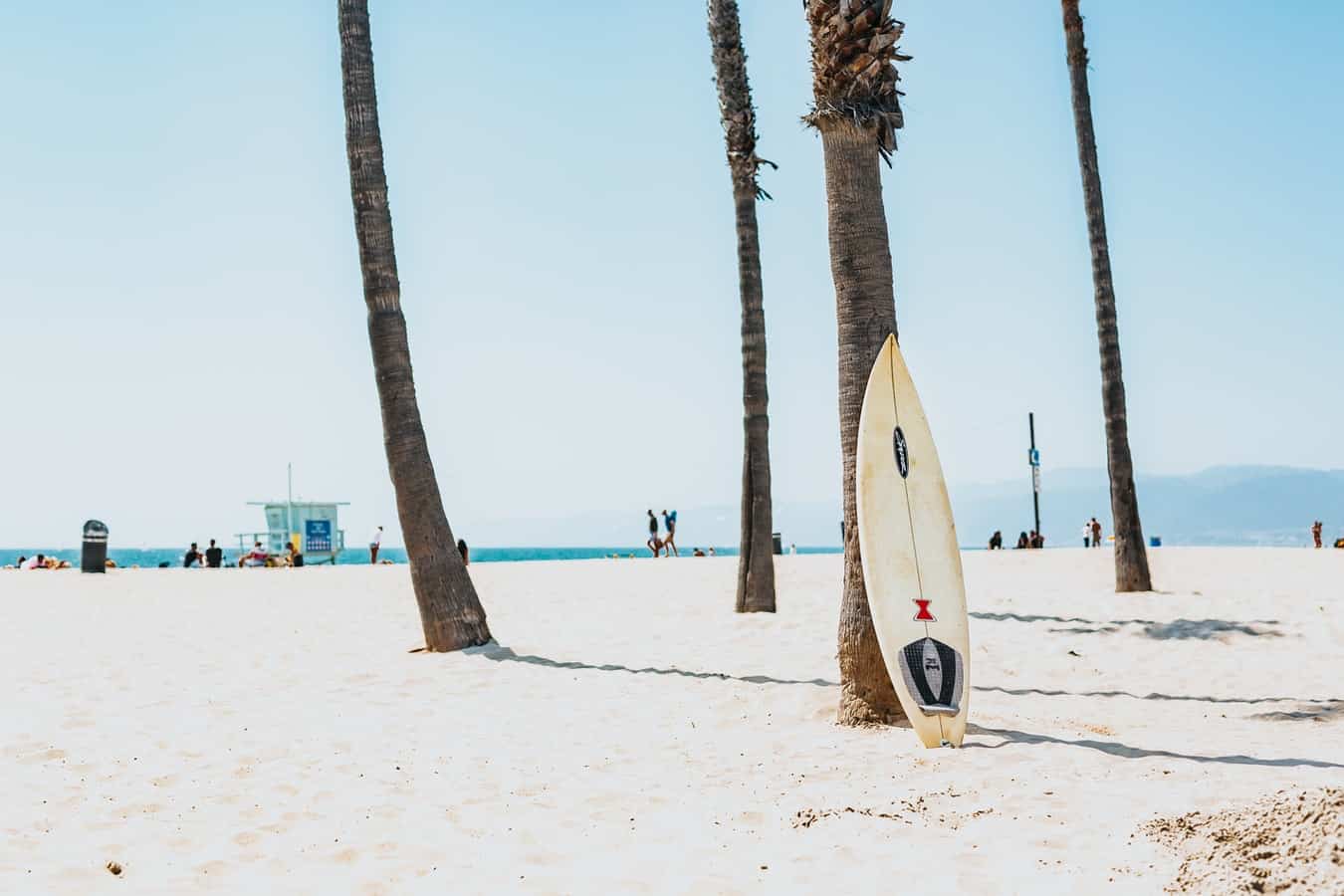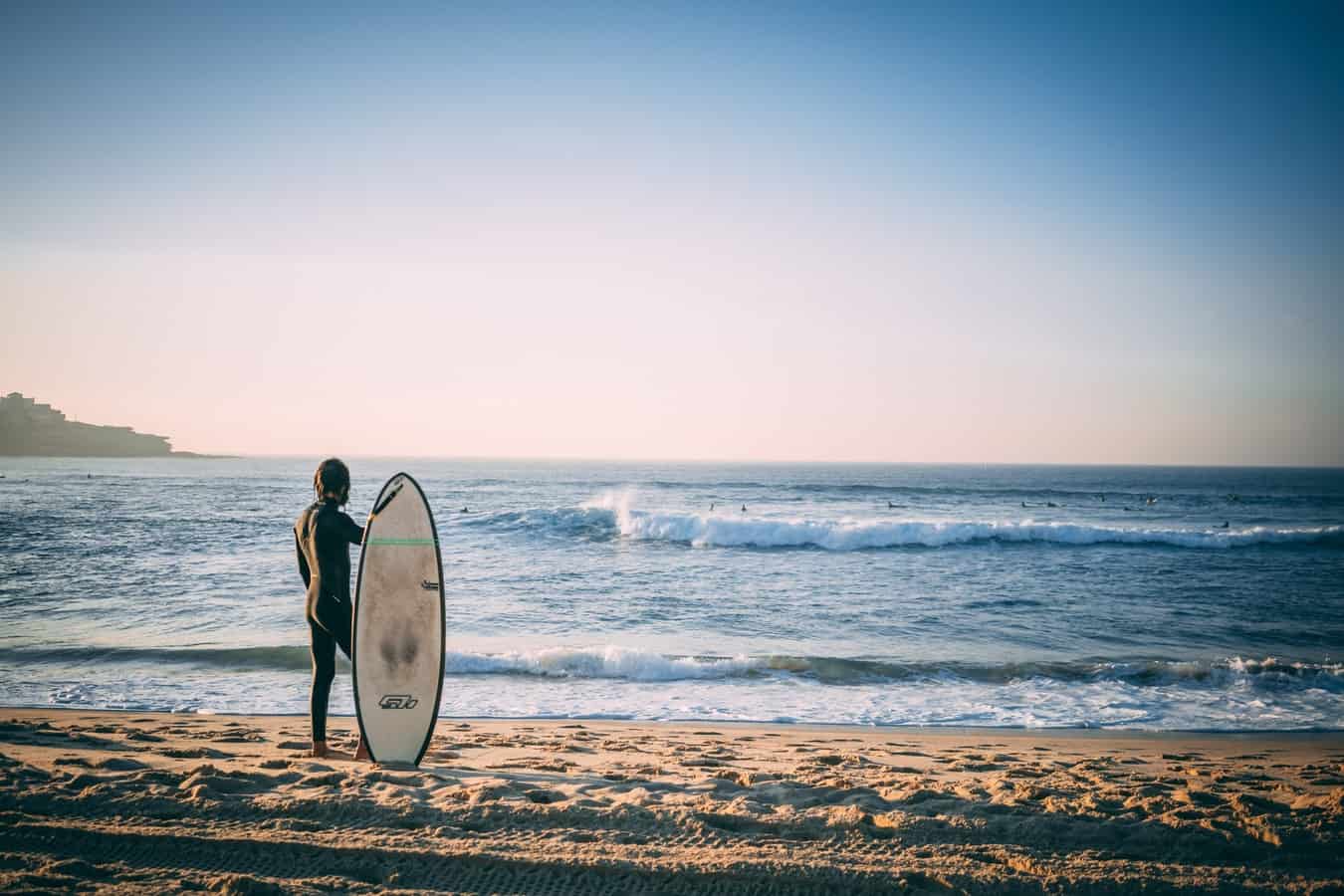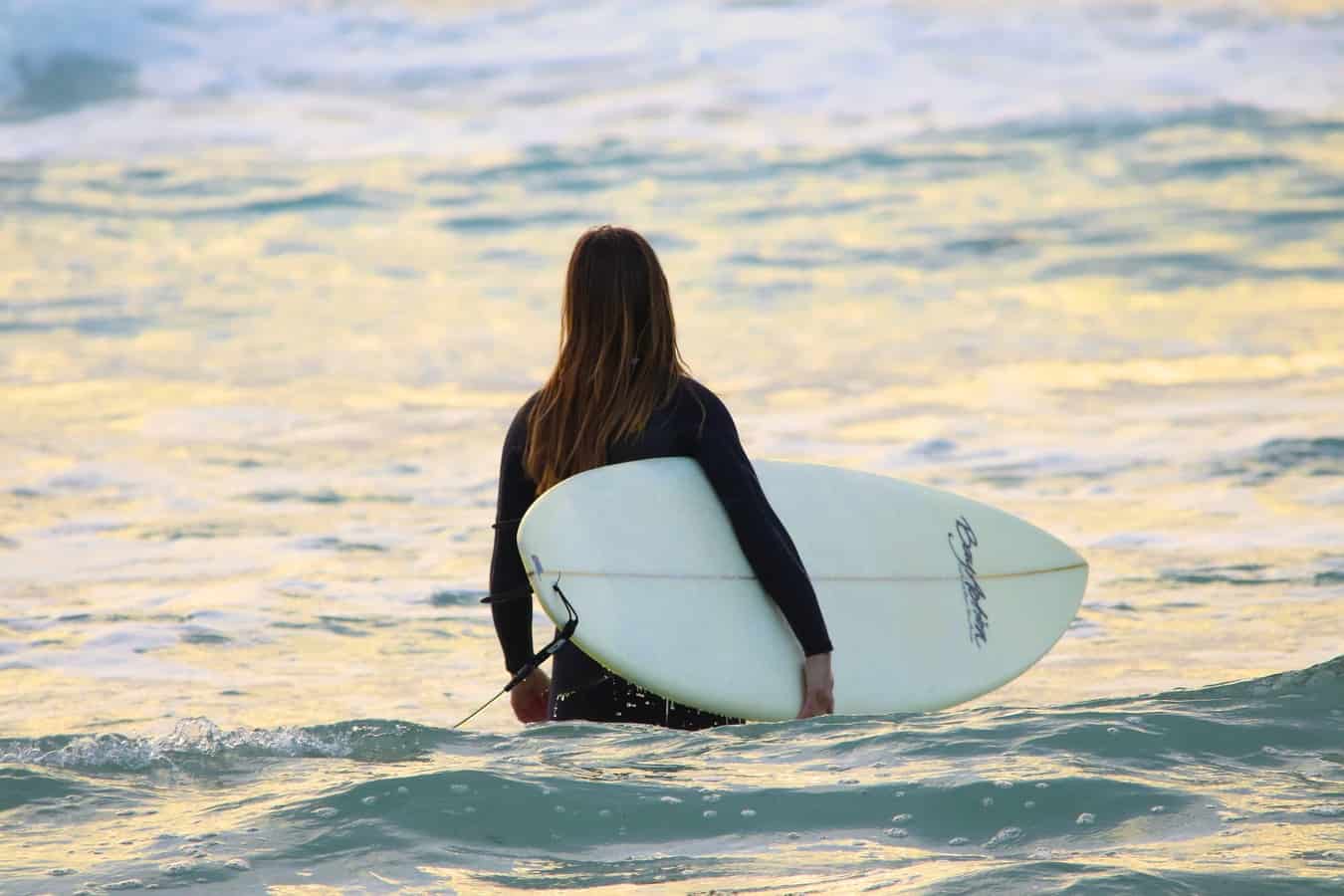When it comes to the physics of surfing, there are a lot of factors to consider. Namely, how your board glides on the water.
This is made up of lots of factors, weight being one of them. So how much do surfboards weigh anyway and why does it matter in terms of surfing?
The average weight of a surfboard is around 13 pounds
Averages are calculated by adding up all the numbers in your data then dividing by how many numbers are in your data.
So using the example of surfboards, if you had 3 boards, one weighing 5 pounds, one weighing 10 pounds and one weighing 20 pounds, the average would be 11.
This means that the weight of your board can vary drastically from the average.
It also means that while 13 pounds is roughly the average of all boards, the answer for your style of board will vary greatly. The average weight of a 5 foot board will be much less than the average weight of a 9 foot board.
With that in mind, the average weight of a shortboard is around 6 – 7 pounds and the average weight of a longboard is around 20 pounds.
In addition to factoring in length, the materials your board is made of will affect your answer. Average weight of a fiberglass epoxy board will differ from the average weight of a soft top foam board.
When it comes to surfboards, weight matters but dimensions and style of board will factor in greatly.
Why Weight Matters
When it comes to your surfboard, why does weight matter at all?
Most importantly, weight will affect your speed while surfing. The lighter the board, the faster you’ll go. This is part of why shortboarders can go faster than longboarders.
By nature, longboards will be heavier than their counterparts.
If your goal is to go faster while surfing, a lighter board will make a difference.
Weight is also part of the puzzle in figuring out how well your board will float. Knowing how well your board will float is huge in your ability to surf on it.
The lighter a board, the more buoyancy, or flotation it will have. Buoyancy matters in how a board will ride. Boards with greater flotation will sit higher above the water and have less drag.
This makes them paddle faster and catch waves more easily, but will maneuver more slowly. A board with less buoyancy will be harder to paddle and catch waves with, but move more easily in the wave.

The Types of Materials Surfboards Use
The materials your board is made of will affect the weight of your board. Over the years the materials used to make surfboards has changed drastically.
Originally boards were made of wood, weighing a hundred pounds or more. Over the years, these absurdly heavy boards have been replaced by lighter constructions.
Today’s boards are generally made using expanded polystyrene foam (EPS) or prolapse polystyrene foam (PPS).
These are the materials on the inside of your board that enables it to float. Expanded polystyrene is the lightest weight of the two foams and as such is the most popular choice of surfboard makers.
Both of these types of foam are harder to hand shape, EPS being most difficult and is often shaped by machines.
The outside construction of most boards is either epoxy resin or polyester resin (fiberglass). Soft top surfboards replace this coating of epoxy or fiberglass with a layer of durable ethylene-vinyl acetate (EVA).
Epoxy and polyester resins coat the inner foam core acting as a hard waterproof barrier. Epoxy offers more water protection over fiberglass, and is also stronger.
This makes epoxy boards generally less prone to damage than a polyester resin board. There is no difference as far as weight goes.
EVA is used on soft top boards for its durability. As its made of a type of foam itself, this outer coating is able to take harder hits than epoxy and fiberglass boards.
Other Factors to Consider in Choosing a Board
Although weight matters in terms of choosing the right board, there are other factors to consider when choosing the right board for you. Namely, volume, length and width
Volume
Volume is the most important factor in determining buoyancy. To calculate volume, multiply the length of your board by the width and then by the height, or in this case the thickness of your board (LxWxH).
The greater the volume, the greater its ability to float. This number on its own doesn’t give you much information as it’s only half the equation. Your own weight is the other factor.
The more you weigh, the more volume your board will need in order to float appropriately. For instance, a 160 pound person will need a board with greater volume than someone weighing 100 pounds for the same buoyancy on the water.
Choosing the right volume of board is determined by the volume to weight ratio.
To calculate, take your weight and divide it by the volume, the answer will be the weight distribution per liter of volume (lbs/l). The higher the resulting number, the smaller the board is relative to the surfer.
Beginners should go for the greatest volume, looking for around 2.0 lbs/l. As you advance in skill as a surfer, you can choose to go for less volume to increase maneuverability.
Most manufacturers have volume calculators on their websites.
Length and Width
Length and width are another important consideration in figuring out the right board for you. There are longboards, shortboards, fish, hybrids and more, all with varying lengths and widths.
Even though a longer board will be heavier, it will also have greater volume and stability, providing an easier riding experience than a shortboard.
At the same time, although a fish could be similar length to a shortboard, it will be wider, again providing a different surfing experience.
The general rule of thumb is the longer a board, the easier it is to ride. This is why longboards are recommended for beginner surfers.
However, due to the extra length and weight, they’re harder to maneuver in the waves.
This is one of the big reasons people transition to a shortboard. However, since they have less volume, shortboards require more effort and skill to catch waves.
Once you’ve picked the general length and width you’re looking for, you also have to factor in your own height and weight. The taller you are, the taller board you’ll need in order to balance.
Similarly, the greater your weight, the longer board you’ll need in order to float. The general rule of thumb is to add about four inches of length for every ten pounds.

Common Board Shapes
Surfboards come in all different dimensions. Different style boards are meant for different skill sets along with different kinds of waves. These are the most popular surfboard shapes
Longboard
Longboards can be anywhere from 8 – 12 feet long. The have the greatest surface area and therefore buoyancy of the boards.
This surface area makes them great in small waves as they can be pulled by the surface of the water. They are heavier and more difficult to turn.
Longboards are generally the best recommendation for beginners.
Funboard
A blend of the longboard and shortboard. Also good for smaller wave conditions, these boards range from 6 – 8 feet long.
Fun boards are a great step down from the longboard and are good for heavier surfers.
Shortboard
Shortboards are often what the average person thinks of when imagining a surfboard. They range from 5.5 feet to 6.5 feet in length.
These boards do well in larger surf as they have less surface area and therefore pull from the water.
They are harder to paddle and catch waves than their longer counterparts, but allow for much greater movement and turning on the waves.
Shortboards are generally recommended for intermediate to advanced surfers
Fish
Fish are similar in length to shortboards but are wider nose to tail. They also have a notch cut out in the back, like a fish’s tail.
Thanks to their greater width, these boards are more stable and have greater volume, making them more stable and a bit easier to ride than the shortboard.
There are other types of surfboard shapes, such as the gun or tow in board, however those are more for competitive surfing while these are the most common styles you’ll see at your local surf break.
Related Questions
Can a Surfboard Have Too Much Volume?
Volume relates to buoyancy, the more volume the better your board floats.
Too much volume will depend on the skill set of the rider. A lot of buoyancy will make it easier to catch waves and balance, but make it harder to turn.
If you’ve progressed in your surfing skill and are finding it hard to twist and turn on the waves, your board may have too much volume for your ability. As you progress as a surfer, you’ll need less volume.
What Size Surfboard is Right for Me?
The right size surfboard will all depend on your level of experience, your height and weight and the types of waves you’ll be riding in.
If you are a more experienced surfer riding smaller waves, you may choose a hybrid board, which is shorter but wider than most shortboards to allow greater surface area.
If you’re very tall over 6 feet, you’ll need a longer board than someone 5 feet tall. The best way to find the right size board for you is to consult other surfers or the employees at your local surf shop.

